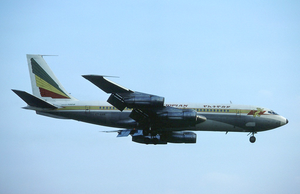Pakistan International Airlines Flight 326
This article has multiple issues. Please help improve it or discuss these issues on the talk page. (Learn how and when to remove these template messages)
|
 A Boeing 720 similar to the hijacked aircraft | |
| Incident | |
|---|---|
| Date | 2 March 1981 |
| Summary | Hijacking |
| Site | en route |
| Aircraft | |
| Aircraft type | Boeing 720 |
| Operator | Pakistan International Airlines |
| Registration | PK-326 |
| Flight origin | Karachi |
| Stopover | Kabul (1st diversion) |
| 1st stopover | Damascus (2nd diversion) |
| Destination | Peshawar |
| Passengers | 135 (inc. 3 terrorists) |
| Crew | 9 |
| Fatalities | 1 |
| Injuries | 0 |
| Survivors | 143 |
In 1981, Al-Zulfiqar led by Murtaza Bhutto hijacked a Pakistan International Airlines flight en route to Peshawar from Karachi, and diverted it to Kabul in March 1981. The hijacking went on for thirteen days, during which Lieutenant Tariq Rahim was shot to death; the hijackers mistakenly believed Rahim to be the son of General Rahimuddin Khan. Rahim was executed following Murtaza Bhutto's conferring with KHAD chief Mohammad Najibullah. The execution forced the Zia-ul-Haq regime to accept the demands of the hijackers, releasing dozens of Pakistan Peoples Party and other leftist political prisoners languishing in Pakistani jails.
Al-Zulfiqar and PSF activist Salamullah Tipu along with three other PSF militants hijacked the plane. The plane was first forced to land at Kabul airport, and was then flown to Damascus. Though undertaken to ‘avenge Zulfiqar Ali Bhutto’s hanging by Zia’, the hijacking was at once condemned by the young co-chairperson of the PPP, Benazir Bhutto, who was languishing in a Karachi jail.
The hijackers demanded that 55 political prisoners be released. These included PPP, PSF, NSF and some Marxist Jiyala activists. Zia-ul-Haq hesitated and Tipu shot dead Captain Tariq Rahim, whom he mistakenly believed to be the son of then-martial law administrator General Rahimuddin Khan on the plane accusing him of being a part of Zia’s coup against Bhutto. He wasn’t.
Around 50 prisoners were eventually released by the Zia-ul-Haq regime. Tipu was thrown in a Kabul prison and eventually executed in 1984 for murdering an Afghan national. His body was never returned, and he is said to have been buried somewhere near Kabul.
The successful hijacking not only saw many of the released men join AZO, but the organisation also welcomed a whole new batch of recruits who travelled across Pakistan’s tribal areas and entered Afghanistan
AZO described itself as a socialist guerrilla outfit, but its main purpose was avenging Bhutto’s death. The organisation was mostly made up of young PSF militants, and members of small left-wing groups such as the Communist Mazdoor Kissan Party. [1]
